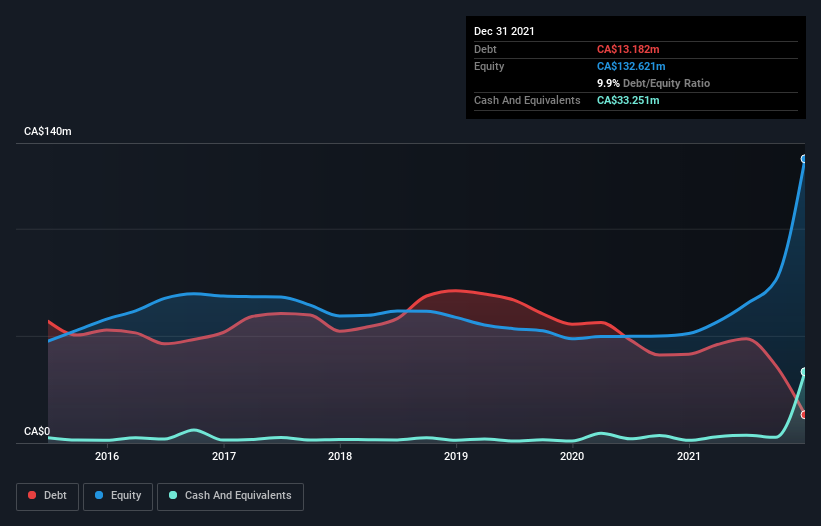Tree Island Steel (TSE:TSL) Has A Rock Solid Balance Sheet
Some say volatility, rather than debt, is the best way to think about risk as an investor, but Warren Buffett famously said that 'Volatility is far from synonymous with risk.' So it might be obvious that you need to consider debt, when you think about how risky any given stock is, because too much debt can sink a company. Importantly, Tree Island Steel Ltd. (TSE:TSL) does carry debt. But the real question is whether this debt is making the company risky.
When Is Debt Dangerous?
Debt assists a business until the business has trouble paying it off, either with new capital or with free cash flow. Part and parcel of capitalism is the process of 'creative destruction' where failed businesses are mercilessly liquidated by their bankers. While that is not too common, we often do see indebted companies permanently diluting shareholders because lenders force them to raise capital at a distressed price. Of course, plenty of companies use debt to fund growth, without any negative consequences. The first step when considering a company's debt levels is to consider its cash and debt together.
View our latest analysis for Tree Island Steel
What Is Tree Island Steel's Debt?
You can click the graphic below for the historical numbers, but it shows that Tree Island Steel had CA$13.2m of debt in December 2021, down from CA$41.4m, one year before. However, its balance sheet shows it holds CA$33.3m in cash, so it actually has CA$20.1m net cash.
A Look At Tree Island Steel's Liabilities
We can see from the most recent balance sheet that Tree Island Steel had liabilities of CA$54.3m falling due within a year, and liabilities of CA$38.9m due beyond that. On the other hand, it had cash of CA$33.3m and CA$38.1m worth of receivables due within a year. So it has liabilities totalling CA$21.9m more than its cash and near-term receivables, combined.
Of course, Tree Island Steel has a market capitalization of CA$140.5m, so these liabilities are probably manageable. However, we do think it is worth keeping an eye on its balance sheet strength, as it may change over time. Despite its noteworthy liabilities, Tree Island Steel boasts net cash, so it's fair to say it does not have a heavy debt load!
Better yet, Tree Island Steel grew its EBIT by 339% last year, which is an impressive improvement. That boost will make it even easier to pay down debt going forward. There's no doubt that we learn most about debt from the balance sheet. But you can't view debt in total isolation; since Tree Island Steel will need earnings to service that debt. So if you're keen to discover more about its earnings, it might be worth checking out this graph of its long term earnings trend.
Finally, while the tax-man may adore accounting profits, lenders only accept cold hard cash. While Tree Island Steel has net cash on its balance sheet, it's still worth taking a look at its ability to convert earnings before interest and tax (EBIT) to free cash flow, to help us understand how quickly it is building (or eroding) that cash balance. Over the most recent three years, Tree Island Steel recorded free cash flow worth 69% of its EBIT, which is around normal, given free cash flow excludes interest and tax. This cold hard cash means it can reduce its debt when it wants to.
Summing up
While Tree Island Steel does have more liabilities than liquid assets, it also has net cash of CA$20.1m. And we liked the look of last year's 339% year-on-year EBIT growth. So is Tree Island Steel's debt a risk? It doesn't seem so to us. There's no doubt that we learn most about debt from the balance sheet. But ultimately, every company can contain risks that exist outside of the balance sheet. For example Tree Island Steel has 3 warning signs (and 1 which can't be ignored) we think you should know about.
At the end of the day, it's often better to focus on companies that are free from net debt. You can access our special list of such companies (all with a track record of profit growth). It's free.
Have feedback on this article? Concerned about the content? Get in touch with us directly. Alternatively, email editorial-team (at) simplywallst.com.
This article by Simply Wall St is general in nature. We provide commentary based on historical data and analyst forecasts only using an unbiased methodology and our articles are not intended to be financial advice. It does not constitute a recommendation to buy or sell any stock, and does not take account of your objectives, or your financial situation. We aim to bring you long-term focused analysis driven by fundamental data. Note that our analysis may not factor in the latest price-sensitive company announcements or qualitative material. Simply Wall St has no position in any stocks mentioned.

